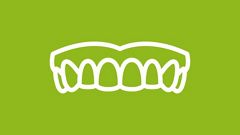IMMEDIATE TREATMENT PROCEDURE
1. Consultation and examination
The dentist will assess your dental and medical history, clarify your expectations and explain your different treatment options. For a successful immediate treatment procedure it is vital that the dental implant(s) can be securely stabilized in the bone immediately when inserted.
2. Clinical assessment, planning and restoration production
The dentist will do a thorough clinical assessment.
Radiographs and CBCT scans show if you are a suitable candidate for an immediate treatment protocol. They show the quality of your bone and whether you have enough bone to stably anchor the implant(s) in your jaw. If not, a standard approach may be the treatment of choice.
Digital scans supply an exact 3D image of your mouth. The dentist uses the data to plan the exact implant position. The dental laboratory uses the data to produce your provisional prosthetic restoration prior to surgery.
3. Tooth extraction, implant and restoration placement
The day of surgery has come and the dentist will do 3 or 4 steps in one go:
- If applicable, the hopeless tooth that must be replaced will be extracted.
- The implant will be placed in either an already healed or freshly extracted area.
- In case of a freshly extracted tooth, small bone augmentation may be required.
- The provisional new crown, bridge or denture which the dental lab has produced in advance is now immediately connected to the implant(s). This step is important to provide esthetics as well as to maintain the gingival contours while the gums are healing.
As a result, you will have a functional new tooth or set of teeth that already look and feel natural. Still, the implant(s) will have to heal. The time will depend on your individual situation.
You will receive detailed instructions on what you can do and should avoid immediately after surgery. For example:
- Apply cooling pads to the outside of the mouth. This will help prevent bleeding and swelling.
- Avoid hot foods and drinks as these may lead to undesired bleeding. Prefer a cold diet.
- Avoid chewing anything hard on the side where the implant was placed.
- Take the prescribed medication as recommended.
Be careful with oral rinses, and only gently brush the surrounding area.
During the healing phase you should stick to soft foods that are easy to chew and avoid alcohol and smoking. Your dentist will give you detailed instructions on what to do and avoid and for how long.
4. Postoperative review
Approximately two weeks after surgery you will return to your dentist for a check.
5. Impression taking and final prosthetic restoration production
After a few months the implant and surrounding tissues are ready to receive a final prosthesis.
A new impression will be taken, either digitally or using an impression material. The dental laboratory will use this data to produce your new final prosthesis that perfectly matches the healed contours.
6. Replacement provisional prosthesis and fitting your final prosthetic restoration
Your dentist will remove the temporary prosthetic restoration, and your final crown, bridge or denture made of a long-lasting material will be connected to the respective implant(s). Necessary adjustments will be made so that your bite is comfortable, functional and esthetically as expected.
From now on you will be able to eat, smile and laugh naturally again.


